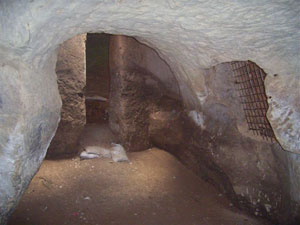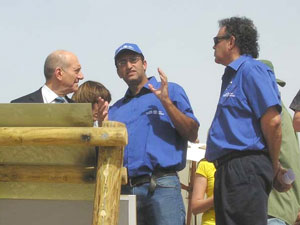A present to the State of Israel for its sixtieth anniversary: Adulam Park

On the occasion of the sixtieth anniversary of the state the Jewish National Fund will give Prime Minister Ehud Olmert and through him, the State of Israel, Adulam Park – a huge park in the Judean Shephelah that extends across some 50,000 dunams and includes a breathtaking landscape, archaeological finds from the time of the Second Temple, foot paths and cycling paths.
Adulam Park is situated south of Bet Shemesh, in the heart of the Judean Shephelah. Nahal HaElla marks the park’s northern boundary and Nahal Guvrin its southern boundary. Together with Britannia Park and USA Park Adulam Park constitutes one of the largest green spaces in the center of the country.
The park was prepared for the public in cooperation with the Israel Antiquities Authority, which excavated and exposed two extremely important archaeological sites there that date to the time of the Second Temple period – Horvat Etri and Horvat Burgin. These sites were major and dynamic Jewish settlements at this time when the entire Judean Shephelah was in fact the center of Jewish settlement in the Second Temple period – a kind of modern day “Metropolitan Tel Aviv”.
The event, with the participation of the prime minister, took place against the background of Horvat Etri, which was exposed in 2000-2001 by archaeologists Amir Ganor and Dr. Boaz Zissu of the Israel Antiquities Authority. The ruin is identified with the ancient Jewish settlement of “Kfar Etara”. It is mentioned in the book The Jewish War by the Jewish historian Josephus, who lived in the Second Temple period, and was vanquished in the destruction that was wrought on Judea in the year 69 CE.
Horvat Burgin, which is currently being excavated by archaeologists Amir Ganor and Alon Klein of the Unit for the Prevention of Antiquities Robbery of the Antiquities Authority, extends across an area of about 60 dunams at the top of a hill and has a commanding view over the surrounding region.

Ganor and Klein assume that Horvat Burgin is in fact Kfar Bish, which is mentioned in the Jerusalem Talmud and the Babylonian Talmud, as well as in Josephus’ writings. Kfar Bish was one of the principal settlements of the Second Temple period, if not the main one among them.
Like many other ancient sites in the region, the ruin suffered from the illicit excavations that were carried out by antiquities robbers who breached and plundered burial caves, industrial installations and columbaria that are located in the middle of the site and along its slopes. The burial caves constitute a focal point especially for robbers since they usually contain valuable and intact artifacts that are hundreds and thousands of years old.
There are dozens of rock-hewn caves and subterranean complexes from different periods at the site. There is also a rather extensive cemetery at Horvat Burgin. Scores of ‘cellars’ were preserved there which are hewn in the chalk bedrock and were used for a variety of purposes such as storehouses, columbaria, olive presses, refuge complexes etc.
Unlike Horvat Etri, which was conquered and vanquished in the Roman destruction of 69 CE, there is no archaeological evidence to indicate a violent conquest at Horvat Burgin. The capitulation by its residents to the Roman military commander as mentioned in the writings of Josephus probably allowed the settlement continued prosperity and afforded it a place as one of the largest and most important settlements in the Judean Shephelah.

Horvat Etri is situated on a spur 406 meters above sea level, in a location that affords it a commanding view over the surrounding region. In the wake of the continuous destruction to the site that was caused by antiquities robbers and in order to prevent further damage, the Israel Antiquities Authority initiated a project the purpose of which is to expose and present Horvat Etri to the public.
This was the site of a rural Jewish settlement that existed from the latter part of the Persian period until the beginning of the Byzantine period, that is to say, for an uninterrupted period of 800 years. The excavation at the site was carried out in 1999-2000 under the direction of Dr. Boaz Zissu and Amir Ganor of the Israel Antiquities Authority, and with the assistance of manpower provided by a project for unemployed laborers from Ofekim, Kiryat Gat, Kiryat Malachi, Rahat and Jerusalem. Conservation and restoration work was carried out at the site by the Conservation Department of the Israel An
tiquities Authority, with the help of the Jewish National Fund and a contribution donated by the “Kramim– HaElla Winery Company”.
From 2000 until the present the archaeological excavations have continued at Horvat Etri with the help of thousands of school children who visit the site annually.
The settlement at the site reached its zenith in the first century CE when its buildings were spread over an area of approximately twelve dunams. At this time a Jewish population resided there as evidenced by the three ritual baths (miqve’ot), stone vessels that were not susceptible to becoming ritually unclean and other artifacts that were discovered including coins from the time of the Great Revolt and the Bar Kokhba uprising and numerous pottery and glass vessels.
The settlement was severely damaged by the Romans in the Great Revolt in 69 CE during the course of the military campaign conducted by the Roman commander Cerealis in Upper Idumaea. The Jewish settlement at the site was renewed in the period between the Great Revolt (66-70 CE) and the Bar Kokhba uprising (132-135 CE). The builders of the settlement renovated the residential quarters, installed underground hiding refuges and systems for collecting water, sealed the breaches in the settlement’s wall and reinforced the settlement’s defenses and security system, all in preparation for the Bar Kokhba uprising.
Based on the archaeological finds that were uncovered at the site the settlement actively participated in the Bar Kokhba uprising and at the conclusion of it was ravished and destroyed in an especially violent manner. Amazing evidence of the destruction was discovered in one of the ritual baths where Jewish warriors that took part in the uprising were buried together with their property and equip eceased had been decapitated by a blow from a sword.ment.

At least one of the dThe principal discovery in the excavation is a public building – a spacious synagogue that measures 7.5 x 13.0 meters and two nearby ritual baths. The architectural plan of this structure, which was erected in the period between the Great Revolt and the Bar Kokhba uprising, is similar to the zealots’ synagogue at Masada and to other public buildings such as those that were uncovered in the region of Modi’in. This is the largest building at the site. According to its architectural plan the building was intended to contain large numbers of the public and it faces Jerusalem. An examination and analysis of all of the data has revealed that this is a public building/synagogue that was used by the settlement’s Jewish residents. If this is indeed the case then what we have here are the remains of one of the earliest synagogues that is currently known to have existed.
Additional Articles ...
Archive